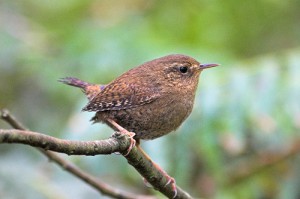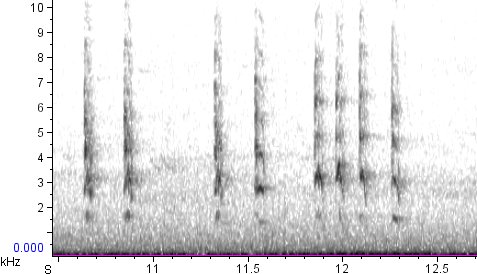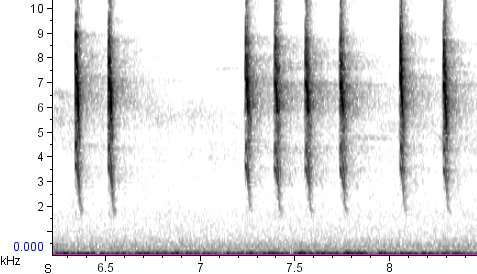Pacific Wren, Part One

The American Ornithologists’ Union Checklist Committee recently updated its slate of taxonomic proposals. Lots of exciting stuff here, including proposed species status for our old friend, the South Hills Crossbill, and a split of Western Scrub-Jay. The proposed split I want to focus on today, though, is one that’s long in coming, and quite likely to pass, in my opinion: the split of Winter Wren into eastern and western North American species.
Why split the Winter Wren? For starters, eastern and western populations are 8.8% divergent in their mitochondrial DNA. (Trust me, that’s a lot.) Songs and calls differ diagnosably. Furthermore, the two forms nest side-by-side in the northern Canadian Rockies without interbreeding. Analysis of vocalizations and genetics haven’t turned up anything that really looks like a hybrid. Really, this looks like a pretty straightforward split, even by the “old” biological species criteria.
So, it looks like come next summer, we’ll probably have a new taxonomy in the genus:
- Winter Wren, Troglodytes troglodytes: breeding from east-central British Columbia east across Canada and down through the Appalachians; wintering in the eastern United States, mostly east of the Great Plains. It’s highly likely that this species will eventually be split from the Eurasian birds, in which case the scientific name of our Winter Wren would revert to Troglodytes hiemalis, a direct translation of its common name in America (Eurasian birds are usually just called “Wren”).
- Pacific Wren, Troglodytes pacificus: breeding in Alaska through the northern Rockies to the Yellowstone area and down the Pacific coastline to Central California; mostly non-migratory, though wandering casually southward in winter. The distinctive Aleutian birds would be included in this species.
How do you tell the two apart by sound? For today, we’ll look at the calls, which is the easiest way to identify them, especially in winter.
Calls


With direct comparison of soundtracks and spectrograms, the differences are obvious. The Winter Wren’s call is much clearer, with discrete harmonic bands; both spectrographically and aurally it is reminiscent of the call of Song Sparrow. The Pacific Wren, by contrast, has a call that is much noisier and higher-pitched, and, on average, slightly briefer. It is often compared to the call of Wilson’s Warbler. Although the call may not look higher-pitched on the spectrogram (since the minimum and maximum frequencies of both calls are about the same), note that the darkest part of the Pacific Wren spectrogram (and therefore the loudest part of the call) tends to concentrate around 6-7 kHz, while the darkest part of the Winter Wren spectrogram comes in at about half that. This accounts for the perceptual difference in pitch.
In my next post I’ll look at how to tell these two species apart by song. As these two are both fantastic singers, it will be a melodious post indeed!
14 thoughts on “Pacific Wren, Part One”
Which wren would be the one I saw years ago in the Ft. Collins, Colorado area? I’ve also seen and heard (through my songfinder) one singing in Adak, Alaska! I even watched this one sing through the scope! So I know I’ve got the Pacific Wren licked. But could my Ft. Collins one be counted as a Troglodytes troglodytes in addition? Ft. Collins is kind of between the mountains and the eastern plains of Colorado! The bird is probably not countable as a Troglodytes troglodytes. Would greatly appreciate if you could just e-mail me “YES” (it is countable) or ” NO” it isn’t! Thanks so much! Mymm P.S. I’m trying to get up to 700–which I doubt I’ll be able to do in my lifetime!
Mymm,
It’s impossible to say which wren you saw in Ft. Collins without more information. So, to be on the safe side, I’d say “NO,” not countable. The one in Adak you can confidently “tick” as a Pacific, though. And if you hear of Winter Wrens in Colorado this season, chances are good they’ll be Winter Wrens from the East, but no guarantees until you hear them call!
Nathan
Dear Nathan,
Thanks for bothering to reply. But I’m still confused. If the default Wren in Colorado is PROBABLY the eastern, then that’s PROBABLY what I’ve seen a couple times in the state. (The other one was in Rye one December) But since Winter Wrens don’t SING when they’re down here I guess there’s no way I’ll ever know! Perhaps they CALL, but I doubt very much I’d hear that through my Songfinder!I’ve only SEEN just glimpses of them! I can’t imagine hearing them unless their call is extremely LOUD. And their song sure isn’t! Oh well. At least I won’t have to bother trying to figure out how to split them properly on my Avisys Software! I was dreading that! Again, thanks! Mymm
The information I have suggests that Winter Wrens are more common in Colorado than Pacific Wrens, but I don’t know if I’d go so far as to say that Winter is the “default.” Although they usually don’t sing in Colorado, they certainly do call, sometimes loudly, and I imagine you should be able to hear them through your Songfinder. Can you hear the calls on this page through your Songfinder?
Best of luck with the little rascals this winter!
Dear Nathan Pieplow,
As a birder in my youth in France I had extensive knowledge of the troglodyte mignon (T. troglodytes). In the eatern US as well as in the rain forest of Oregon when I heard the song of a troglodytes so “close, quasi identical” to that of the European form, I always thought that I have been dealing with the same and unique species. Actually this may be the only passerine with the same song accross the two continents.
I have serious problems with the excessive tendancy of making new species.
You indicate that no hybrids are known between the two forms. Let’s be realistic! Who looks at both parents of winter wren feeding a progeny in the dark underwoods! It is obviously a lot easier as a bird grows up to characterize an hybrid duck or gull!
This is my two-cents!
You have an interesting article. nevertheless.
Dominique
Dear Nathan,
I have listened carefully to these two wren songs and the only OBVIOUS difference to me is that the Pacific Wren’s seems drier and wispier with less overtones, and thus less musical richness than the Winter’s. (Of course, this could have something to do with the recording equipment, distance from the birds, etc.) A more subtle difference is the syncopation at the end of the Winter Wren’s song–which makes his more interesting! However, this could just be an accident! I really couldn’t find any consistent PATTERNS anywhere in the two songs. One goes 3,2,2,1,3,2,2,2,2,2,4 fast, 5 syncopated and 5 more syncopated differently. The other much simpler one of the “Pacific” Wren goes 2,4+3, 3,1,3,2,3,3,3,3. I’d have to have an awful lot of experience with the calls of BOTH to sort all this out! I probably couldn’t hear EITHER wren, even with my songfinder on! (Songfinders lower the pitch, so that could pose a problem!)I don’t expect to EVER list the “Eastern” one in Colorado ‘cuz of my hearing problem…but I’ve enjoyed analyzing musically your two examples which I COULD hear! I was hoping the comparison would be more like that of Eastern vrs. Western Wood Pewee. But this bird isn’t one of those obvious duos–unfortunately! Mymm
Mymm,
You’re right, the patterns are too complex and variable to be of much help in distinguishing these wrens. But the difference in tone quality is noticeable.
Are you using your Songfinder to listen to the recordings on the computer? If not, give it a try. If you can hear what’s on the computer, you should be able to hear the wrens in your Songfinder in the field.
My, we’re having quite a conversation about these wrens! Just now I tried listening to the wrens through my Songfinder, standing about 15-18 feet away. AND THEY WERE MAGNIFIED! However,it was much harder to distinguish qualitative differences–probably ‘cuz the Songfinder lowers the pitch of everything. But with a little practice I was finally able to tell that the Pacific sounded more brusque and mechanical and the Winter had a bit more musical timbre. This tells me two things: 1) that I probably WOULD be able to hear a W.W. calling in the field through my Songfinder, assuming it wasn’t more than 15 feet away and everything was quiet and 2) that I’d have to really work at analysing the song quality in a way people with normal hearing wouldn’t. If I KNEW for certain that Eastern one was going to hang around there near Boulder, I’d be willing to go for it…since I’d probably be banking another LIFER! But it is too far to go, too cold!, and too chancy knowing these wrens! Perhaps one’ll turn up here at Valco! Mymm
Mymm, the last time I recall a Winter Wren being found in Fort Collins (about 3-4 years ago by Tony Leukering down by the Poudre River), it was the Pacific form. So even if the eastern form occurs more commonly in Colorado or even Fort Collins, there’s just no way to assert confidently that you encountered one or the other in that instance.
For now, I’m off to Longmont in a bit to find this bird (or hopefully, birds) and try to listen for their calls.
Today (12/17/09) I had absolutely SMASHING looks at Bill Maynard’s EASTERN Winter Wren up at Fountain Creek. I didn’t go up there feeling very sanguine about seeing and/or hearing it as I have NEVER encountered a WW on my own in Colorado. (Only the Pacificus species in Oregon.) Even though Bill had given excellent directions to one of the exact spots where he’d seen it, it STILL took me about 2 1/2 hours of trudging back and forth and/or sitting momentarily in this spot or that spot in the dry channel before I got lucky. BUT BOY WAS IT EVER WORTH THE WAIT! I finally nabbed it up by the boulders near where the irrigation water comes out (in the summer)–a place I’d sat in several times before! But I must have been sitting on the wrong side of the channel! Anyway, suddenly the little fellow landed in a bush across from me and put on quite a show! I have NEVER had such a satisfying experience with a WW! He was bobbing and ducking this way and that as if to show off all sides of him! I even watched his little throat moving as he called! Through my Songfinder it just sounded like “Chip, Chip, Chip, Chip, Chip. Or maybe “Cheep, cheep, cheep, cheep, cheep”–very ordinary and not even rhythmic. But of course since the Songfinder lowers the pitch of everything, it’s hard to judge what he REALLY sounded like.
His color in front was very light–from under his chin way down into his lower belly. Only the tips of his wings–laid back against his body–and his little tail seemed reddish. If he really WAS the eastern wren he’ll be a LIFER for me, after the split. Assuming of course, that Bill called him right. And if Bill Maynard doesn’t know, who does? I would like to have seen the other one up there for comparison–though I already have Pacificus from both Oregon and Alaska. I tried a little in the afternoon, but the directions were not as precise as for the “eastern” so I didn’t linger. Since the two wrens are really rather close together spatially–within easy walking distance–I wonder if they might be a pair? I mean how possible is it that TWO WWs would be within such a short distance of each other? Also, how much color variation–light to dark–might they show individually? And/or do they possibly interbreed, etc.? These are just a few questions I’ve been mulling over….in the end I will probably go ahead and count the wren as an eastern Hyemalis, or however it is you spell that.Thanks, Bill!
Dear Nathan,
You can delete all the stuff I’ve written to you up to know re IDing the two wrens! I am satisfied I truly DO have them both now as lifers and my outdated meanderings are just cluttering up your blog. But when the time comes to change my Avisys records, I would greatly appreciate knowing how to deal with the upcoming split! Like Step 1, Step 2, etc. THAT is more daunting than trying to ID the wrens! Thanks much! Mymm
Comments are closed.